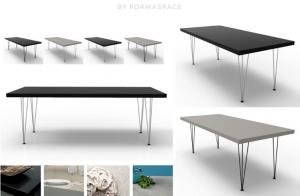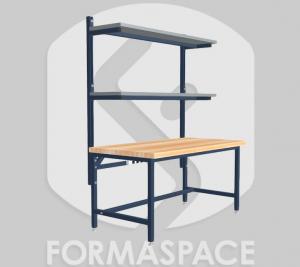10 Key Furniture Manufacturing Trends for 2021

Shown above is a sneak peek of a new mid-century modern inspired line of residential tables coming soon from Formaspace.
Find out what are the new trends emerging in the furniture manufacturing market as companies retool their office environments after Covid-19 disruption.
Today’s consumers want choice, and the newest online sales tools allow them to visualize and personalize their furniture purchases before placing an order.”
AUSTIN, TEXAS, UNITED STATES, April 23, 2021 /EINPresswire.com/ -- What are the latest developments affecting the furniture manufacturing market?— Formaspace
We take a look at the 10 most important trends that will drive the industry forward in 2021.
Trend 1: Office Furniture Sales Shift Away From Traditional Office Lines To Meet Demand For Work From Home (WFH) And Residential-Oriented Products
The Coronavirus pandemic hit the $12.5 billion office furniture business especially hard in the past year as many office customers shut their doors in favor of allowing their employees to Work from Home (WFH).
Not all furniture market segments suffered as much of a downturn as office furniture, however; for example, laboratory furniture sales have maintained momentum thanks to increased investment in biotech research and clinical testing laboratories.
But the big breakout sales star has been residential-oriented furniture products, as employees upgraded their home office environments to make them more productive and functional, and renovated their living quarters (including outdoor areas) to make them a more comfortable environment for enjoying many months of “lockdown.”
Analysts at Quintana Research and Consulting predict the global home office furniture market segment will see compound annual growth rates (CAGR) of around 7.5% during 2020-2026 – which points to the long-lasting impact of the WFH trend.
Trend 2: E-Commerce Sales Take Off As Augmented Reality And Visualization Tools Assist In Furniture Product Personalization And Purchasing Decision
According to Statistica, e-commerce revenue will reach $2.7 trillion in 2021, with the average user spending just over $700 annually.
Overall, E-commerce CAGR is projected to increase by 6.29% between now and 2025. And user penetration will also grow substantially – from an estimated 50.8% of shoppers using e-commerce today to more than 63% by 2025.
Many analysts point to the Coronavirus lockdown over the past year as one of the reasons major e-commerce giants have grown so spectacularly over the past year – Amazon’s revenue is nearing $400 billion, Walmart’s revenue (including physical store sales) is north of $550 billion, and Ikea’s parent holding company reports revenue of over $45 billion.
The rapid update of e-commerce sales in the home furnishings market is causing quite a few retail companies to restructure their operations.
For example, at Williams Sonoma (whose customer-facing brands include Williams Sonoma, Pottery Barn, and West Elm), president and CEO Laura Alber recently announced in an earnings conference call that “E-commerce accelerated sequentially to a record net comp of over 49%, and we were pleased to see our store performance improved throughout the quarter to a net negative 11% comp. Even more encouraging is the retail demand comp at negative 4%.”
In plain English, Alber is saying that while e-commerce is booming, physical store sales are down, albeit not as bad as before. Julie Whalen, William Sonoma’s CFO, admits this means more restructuring is in the offing: “Our plan, currently, is to close approximately 40 stores this year. Stores continue to be a competitive advantage as people like to see merchandise in-person. However, we are anticipating a future with fewer, better, more profitable stores.”
For a long time, the common consensus was that furniture sales were incompatible with e-commerce. Analysts believed that consumers wanted to physically touch and handle furniture products before making a purchasing decision.
However, conditions are changing.
First, more “digital native” Millennial and Gen Z customers are now “decision-makers”, a cohort that is much more comfortable shopping online for all kinds of products, including furniture, fashion, and prescription eyeglasses, that were once thought to be unsuitable for e-commerce first sales.
The second factor that’s changed is the rise of personalization.
Today’s consumers want choice, and the newest online sales tools allow them to visualize and personalize their furniture purchases before placing an order.
Custom photorealistic visualization tools let consumers evaluate material choices (including metal and wood materials, fabrics, surface treatments, and color choices) as well as provide the ability to personalize furniture designs (with elements such as custom storage components, built-in lighting, phone charging pads, or hidden power and data connections) before making a final purchase.
Augmented reality (AR) tools are another factor that’s helping fuel the growth in online furniture sales. Sophisticated AR tools help consumers see exactly what their furniture will look like in their home environment by matching 3D images of furniture with live video captured by their handheld smartphones.
Trend 3: Race To Renovate And Update Office Furnishings And Layouts To Make Working In The Office More Attractive To Employees
The success of Coronavirus vaccines from Moderna and Pfizer in preventing serious illness (as well as inhibiting the spread of the virus by those who have been vaccinated) is leading many business executives to draw up plans for workers to once again return to the office.
For example, Microsoft recently published an extensive analysis of the pros and cons of Working from Home (WFH) that’s well worth reading; it goes a long way to explain why they have reopened their offices worldwide as part of a new post-Covid hybrid work program.
1. Flexible work is here to stay
2. Leaders are out of touch with employees and need a wake-up call
3. High productivity is masking an exhausted workforce
4. Gen Z is at risk and will need to be re-energized
5. Shrinking networks are endangering innovation
6. Authenticity will spur productivity and wellbeing
7. Talent is everywhere in a hybrid work world
Key Points Of Microsoft Predictions For The Future Of Work, Including Work From Home (WFH) And Hybrid Home/Office Work Scenarios
But just announcing that the office is reopening may not be sufficient to lure WFH workers back.
As we invite employees to return to the office, we need to rebuild confidence and create a compelling reason for workers to return – e.g. an attractive environment where people look forward to coming into the office.
That’s why many companies (Formaspace included) are currently undertaking major office renovations that will make the office environment feel safer and more productive for returning workers – as well as supporting those who will continue to work part-time from home.
Trend 4: Using Accessory Mods And Furniture Hacks To Increase Space Separating Workers In The Office – Without Creating Dark, Claustrophobic Environments
The Coronavirus pandemic has dramatically changed our perceptions of what is “safe” and “appropriate” in office design.
Read more...
Julia Solodovnikova
Formaspace
+1 800-251-1505
email us here
Visit us on social media:
Facebook
Twitter
LinkedIn



